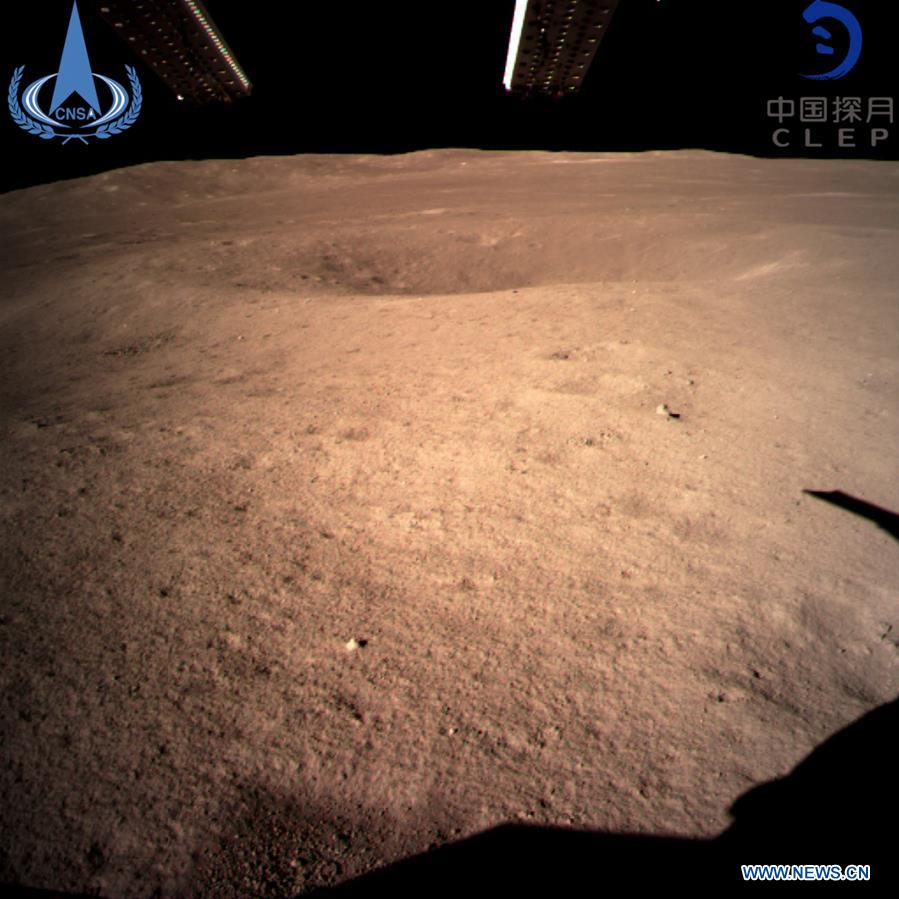On Friday, July 19th, China’s Tiangong-2 (“Heavenly Palace”) space laboratory successfully entered Earth’s atmosphere under controlled conditions and burned up above the South Pacific Ocean. This marked the successful completion of all of Tiangong-2’s tasks, which constituted China’s second attempt at testing their capability to conduct research and human operations in Low Earth Orbit (LEO).
Continue reading “China’s Tiangong 2 was Destroyed Last Week, Burning up in the Atmosphere Over the South Pacific Ocean”Chang’e-4 Lander and its Rover Have Turned up new Mysteries on the Moon’s far side. The Moon’s Mantle Blasted Onto the Surface?
On January 3rd, 2019, the Chinese National Space Administration (CNSA) successfully landed their Chang’e-4 mission on the far side of the Moon. This mission represents a major milestone for China, being the fourth lander-rover mission to be sent to the Moon, and the first mission in history to land on the “dark side of the Moon”. And what it manages to uncover
For example, the mission’s Yutu-2 (Jade Rabbit-2) rover made an impressive find that may confirm a theory about lunar impacts. After collecting spectral data from the moon’s largest crater (the South Pole-Aitken Basin) the Chang’e-4 mission team from the Chinese Academy of Sciences (CAS) concluded that the impact that created the Basin turned up material from deep within the Moon’s mantle. This finding could offer new insight into how the Moon evolved over the course of billions of years.
Continue reading “Chang’e-4 Lander and its Rover Have Turned up new Mysteries on the Moon’s far side. The Moon’s Mantle Blasted Onto the Surface?”China’s Lunar Rover Wakes Up and Gets to Work for its 3rd Lunar Day
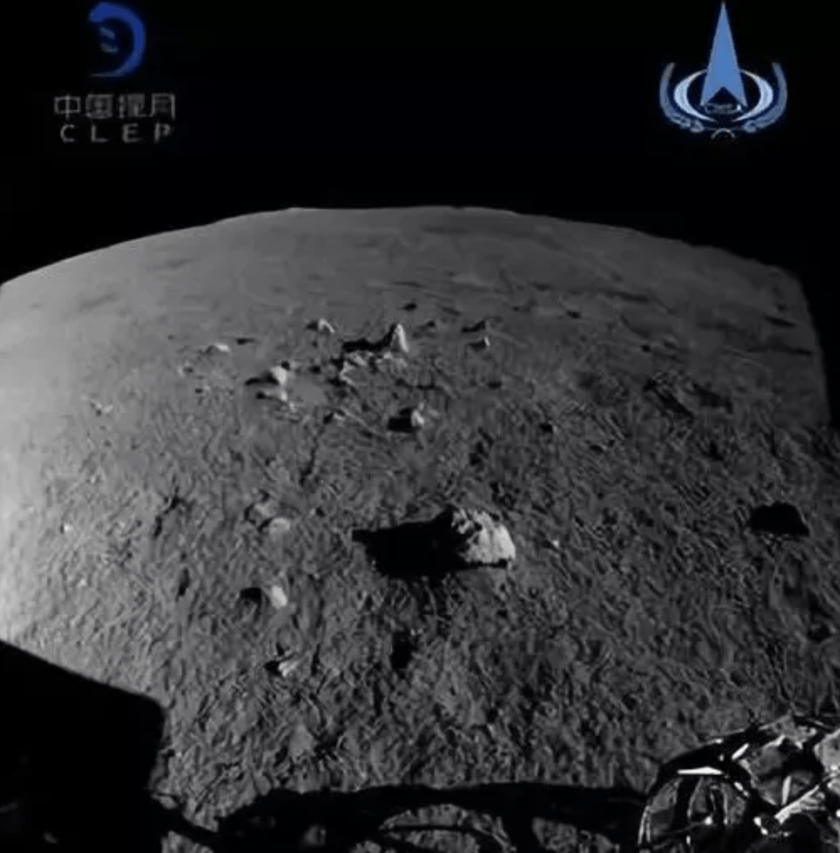
The China National Space Administration (CNSA) has released some new photos and updated the world on their lunar rover mission. The Yutu-2 rover is working its way into the history books on the lunar far side, exploring the Von Karman crater. It’s third lunar day is now in the record books.
Continue reading “China’s Lunar Rover Wakes Up and Gets to Work for its 3rd Lunar Day”The Milky Way is Actually Warped

For centuries, astronomers have been studying the Milky Way in order to get a better understanding of its size and structure. And while modern instruments have yielded invaluable observations of our galaxy and others (which have allowed astronomers to gain a general picture of what it looks like), a truly accurate model of our galaxy has been elusive.
For example, a recent study by a team of astronomers from National Astronomical Observatories of Chinese Academy of Sciences (NAOC) has shown that the large-scale structure of the Milky Way is quite warped. Based on their findings, it appears that this effect becomes increasingly evident the farther away one ventures from the core.
Continue reading “The Milky Way is Actually Warped”There’s Life on the Moon! China’s Lander Just Sprouted the First Plants
It’s official, for the first time ever, scientists have found a living organism on the Moon! Well, not so much found, we put it there. But the implications are immense nonetheless! According to photos and a statement released by the China National Space Administration this week (Mon. Jan. 14th), the Chang’e-4 mission’s Lunar Micro Ecosystem (LME) experiment has produced its first sprouted plant.
Continue reading “There’s Life on the Moon! China’s Lander Just Sprouted the First Plants”Incredible Descent Video of the Chinese Lander to the Lunar Far Side
On January 2nd, 2019, China’s Chang’e-4 lander made a successful landing on the far side of the Moon. The China National Space Administration (CNSA) and the Chinese Lunar Exploration Program (CLEP) report that after 9 days on the surface, the mission is in good shape. The Yutu-2 rover has been deployed and has begun exploring the Von Karman crater.
CNSA has released some video of the mission, including a video of Chang’e-4’s historic descent. Thanks to the hard-working people at the Planetary Society, and to Andrew Jones who reports on the Chinese Space Program, we have a handful of new videos and images of the Chang’e-4’s mission to enjoy.
Continue reading “Incredible Descent Video of the Chinese Lander to the Lunar Far Side”China’s Chang’e-4 Lands on the Far Side of the Moon
Since the turn of the century, China has worked hard to become one of the fastest-rising powers in space. In 2003, the Chinese National Space Administration (CNSA) began sending their first taikonauts to space with the Shenzou program. This was followed by the deployment of the Tiangong-1 space station in 2011 and the launch of Tiangong-2 in 2016. And in the coming years, China also has its sights set on the Moon.
But before China can conduct crewed lunar missions, they must first explore the surface to locate safe landing spots and resources. This is the purpose behind the Chinese Lunar Exploration Program (aka. the Chang’e program). Named after the Chinese goddess of the moon, this program made history yesterday (Thursday, Jan. 3rd) when the fourth vehicle to bear the name (Chang’e-4) landed on the far side of the Moon.
Continue reading “China’s Chang’e-4 Lands on the Far Side of the Moon”China is Working on Their Own Reusable Rocket: the First Stage of the Long March-8, Which Could Launch in 2021
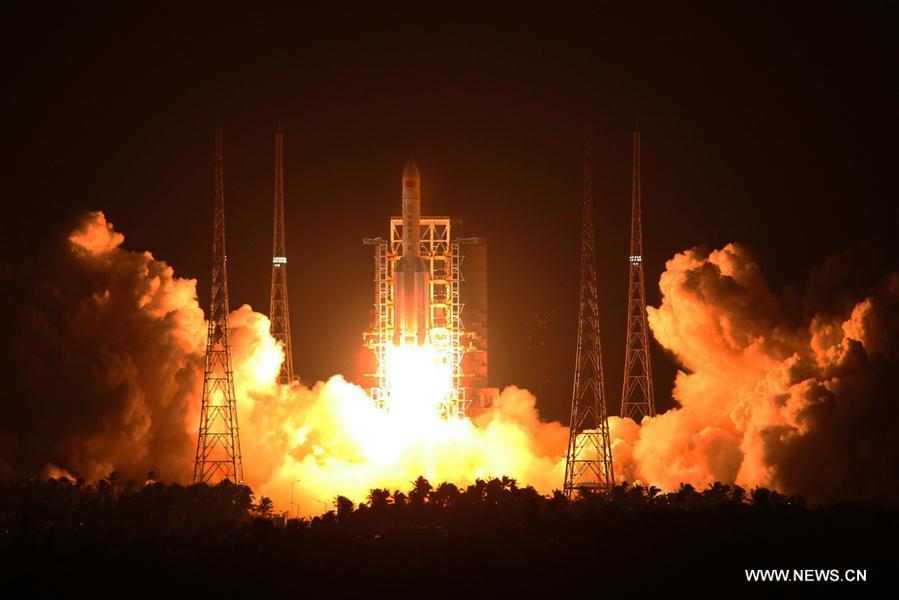
In recent decades, China’s space program has advanced considerably. In addition to deploying their first space station (Tiangong-1) and developing a modern rockets (the Long March 5), the nation has also sent robotic mission to the lunar surface and plans to conduct crewed missions there in the coming years. To this end, China is looking to create a new series of rockets that will enable them to explore the Moon and maybe even Mars.
One of the rockets they use to accomplish these goals is known as the Long-March 8, which is expected to make its maiden flight around 2021. According to a statement made by the chief rocket designer (Long Lehao) during a recent space conference in Harbin, China, the rocket will also include a reusable first stage. This latest announcement shows that China is also pursuing reusable launch vehicles to lower costs and increase their presence in space.
According to the China Space Report, the Long March 8 (Changzheng 8, or CZ-8) is a medium-lift vehicle intended for Sun-Synchronous Orbit (SSO) missions – i.e. where payloads are delivered to a nearly polar orbit around a planet. Consisting of two stages and two boosters, this rocket will reportedly have a payload capacity of 3000 to 4,500 kg (6600 to 9900 lbs) to SSO.
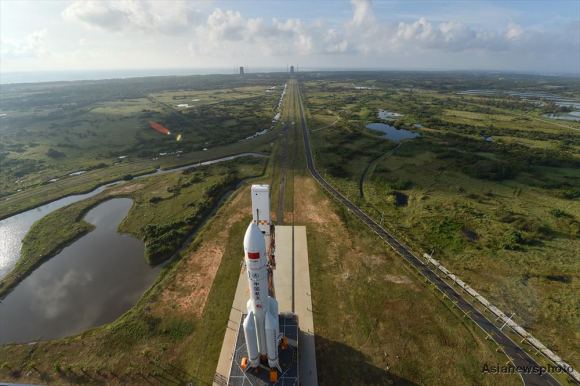
The first stages on this rocket are believed to be based on the first-stage of the Long March 7, which are powered by two single-chamber YF-100, 1,200 kN-thrust engines fueled by LOX/kerosene. Based on Long’s statement, the first stages and boosters are expected to be retrieved through vertical landing (similar to SpaceX’s Falcon 9 and Falcon Heavy rockets).
However, according to Bao Weimin, the director of the Science and Technology Commission of the China Aerospace Science and Technology Corporation, the Long March 8 will use different technologies that those employed by SpaceX. The purpose of this rocket will be to provide commercial launch services to customers from around the world.
As Long indicated during the course of the conference (according to China Daily):
“China’s aerospace industry is making efforts to develop low-cost vehicles that can enter space rapidly to support future large-scale space exploration and promote a commercial space industry.”
In addition, Long also emphasized that China will be making efforts to address an ongoing problem with its younger Long March rockets, which is controlling where they fall. Currently, landing areas have to be are evacuated at every launch since these rockets rely on toxic chemicals. And with launches becoming more frequent, controlling where these rockets fall is becoming a major priority.

“As the current Long March 2, 3, 4 series rockets are fueled by toxic propellants, they cannot be recycled,” said Long. “But we are developing technologies to precisely control the fall of the rocket remains to ensure safety.”
Lastly, Long indicated what lies ahead for China’s space program and commercial spaceflight. By 2025, he claimed, reusable carriers will be developed for conducting suborbital space flights. By 2030, China National Space Agency will be conducting launches with rockets that rely on two reusable stages and will have achieved complete reusability by 2035. He also hinted how by 2040, China will be using reusable carrier rockets that will rely on hybrid-power sources.
All of this will allow for cheaper and more efficient launch services, facilitate spaceflight for private citizens, and allow for the commercialization of Low Earth Orbit (LEO). These goals are in keeping with what space agencies like NASA and private aerospace companies like SpaceX have in mind for the coming decades. In this sense, China is indicating that it intends to parallel other major powers in space by following a similar path.
Further Reading: China Daily
Tiangong-1 Splashes Down in the Pacific Ocean
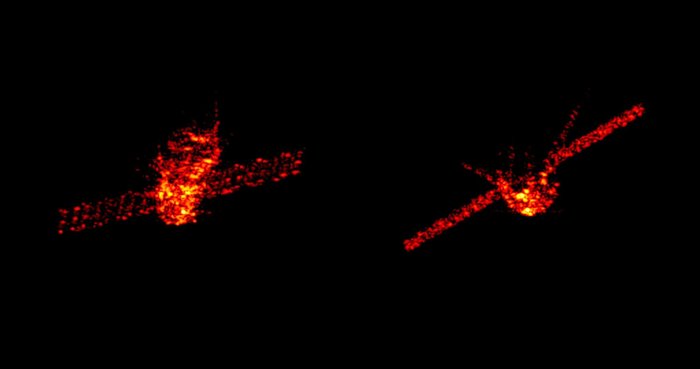
Over the weekend, multiple space agencies’ had their instruments fixed on the skies as they waited for the Tiangong-1 space station to reenter our atmosphere. For the sake of tracking the station’s reentry, the ESA hosted the 2018 Inter Agency Space Debris Coordination Committee, an annual exercise that consists of experts from 13 space agencies taking part in a joint tracking exercise.
And on April 2nd, 02:16 CEST (April 1st, 17:16 PST), the US Air Force confirmed the reentry of the Tiangong-1 over the Pacific Ocean. As hoped, the station crashed down close to the South Pacific Ocean Unpopulated Area (SPOUA), otherwise known as the “Spaceship Cemetery”. This region of the Pacific Ocean has long been used by space agencies to dispose of spent spacecraft after a controlled reentry.
The confirmation came from the Joint Force Space Component Command (JFSCC) on April 2nd, 0:400 CEST (April 1st, 19:00 PST). Using the Space Surveillance Network sensors and their orbital analysis system, they were able to refine their predictions and provide more accurate tracking as the station’s reentry time approached. The USAF regularly shares information with the ESA regarding its satellites and debris tracking.

As with the ESA’s coordination with other space agencies and European member states, JFSCC’s efforts include counterparts in Australia, Canada, France, Germany, Italy, Japan, South Korea, and the United Kingdom. As Maj. Gen. Stephen Whiting, the Deputy Commander of the JFSCC and Commander of the 14th Air Force, indicated in a USAF press release:
“The JFSCC used the Space Surveillance Network sensors and their orbital analysis system to confirm Tiangong-1’s reentry, and to refine its prediction and ultimately provide more fidelity as the reentry time approached. This information is publicly-available on USSTRATCOM’s website www.Space-Track.org. The JFSCC also confirmed reentry through coordination with counterparts in Australia, Canada, France, Germany, Italy, Japan, South Korea, and the United Kingdom.”
The information is available on U.S. Strategic Command’s (USSTRATCOM) website – www.Space-Track.org. Holger Krag, the head of ESA’s Space Debris Office, confirmed the reentry of Tiangong-1 shortly thereafter on the ESA’s Rocket Science Blog. As he stated, the reentry was well within ESA’s earlier reentry forecast window – which ran from April 1st 23:00 UTC to 03:00 UTC on April 2nd (April 2nd, 01:00 CEST to 05:00 CEST):
“According to our experience, their assessment is very reliable. This corresponds to a geographic latitude of 13.6 degrees South and 164.3 degrees West – near American Samoa in the Pacific, near the international date Line. Both time and location are well within ESA’s last prediction window.”

China’s Manned Space Agency (CMSA) also made a public statement about the station’s reenty:
“According to the announcement of China Manned Space Agency (CMSA), through monitoring and analysis by Beijing Aerospace Control Center (BACC) and related agencies, Tiangong-1 reentered the atmosphere at about 8:15 am, 2 April, Beijing time. The reentry falling area located in the central region of South Pacific. Most of the devices were ablated during the reentry process.”
As Krag noted, the ESA’s monitoring efforts were very much reliant on its campaign partners from around the world. In fact, due to when the station entered the Earth’s atmosphere, it was no longer visible to the Fraunhofer FHR institute’s Tracking and Imaging (TIRA) radar, which provides tracking services for the ESA’s Space Debris Office (SDO).
Had the station still been in orbit by 06:05 CEST (21:00 PST), it would have still been visible to the institute’s TIRA radar. Some unexpected space weather also played a role in the station’s reentry. On March 31st, the Sun’s activity spontaneously dropped, which delayed the Tiangong-1’s entry by about a day.
“This illustrates again the dependence that Europe has on non-European sources of information to properly and accurately manage space traffic, detect reentries such as Tiangong-1 and track space debris that remains in orbit – which routinely threatens ESA, European and other national civil, meteorological, scientific, telecomm and navigation satellites,” said Krag.
While news of the Tiangong-1’s orbital decay caused its share of concern, the reentry happened almost entirely as predicted and resulted in no harm. And once again, it demonstrated how international cooperation and public outreach is the best defense against space-related hazards.
Further Reading: Vandenburg Air Force Base,
Here’s How to Follow the De-Orbit of Tiangong-1, now Estimated to Happen Between March 30 and April 2
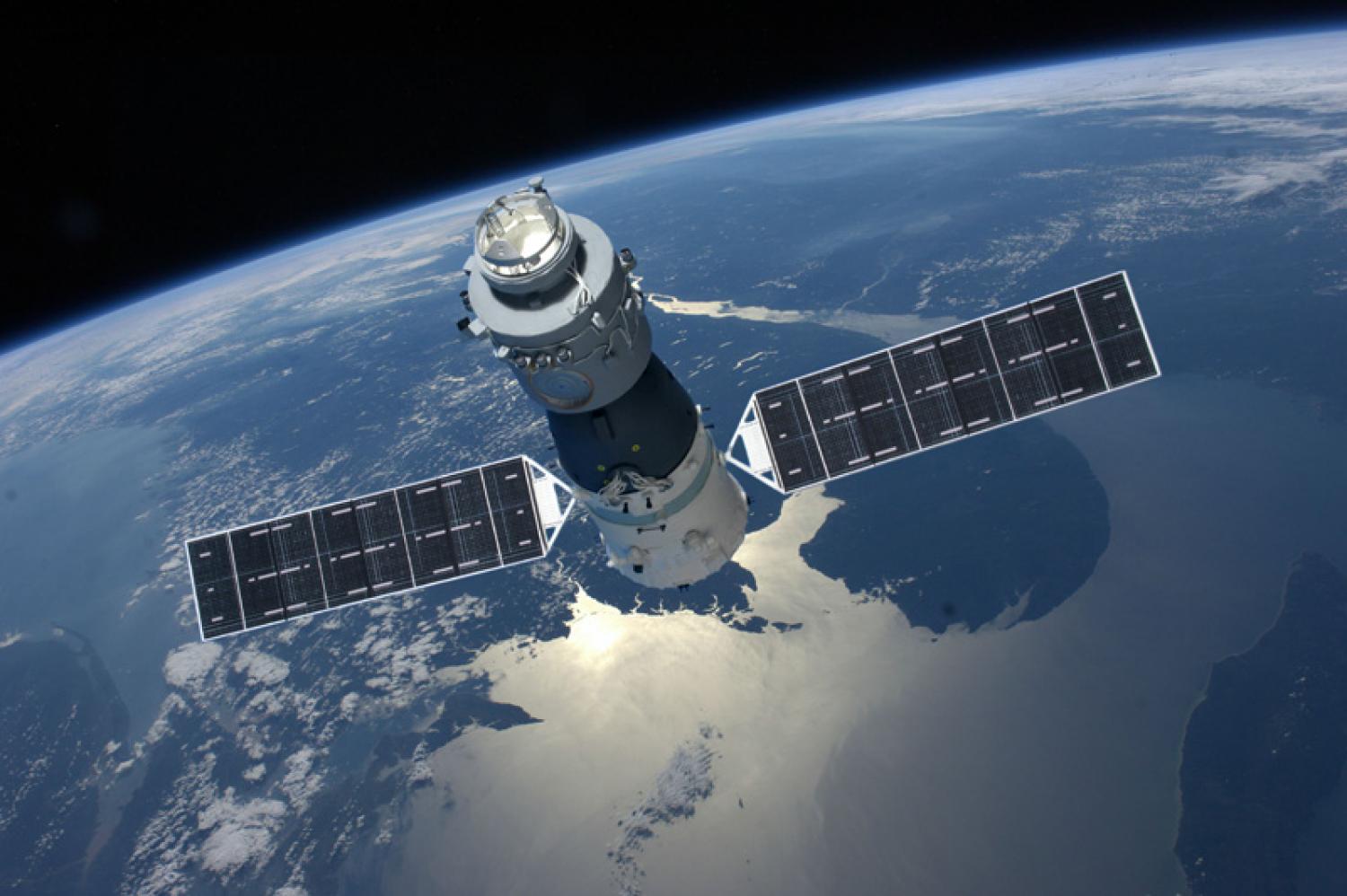
China’s Tiangong-1 space station has been the focus of a lot of international attention lately. In 2016, after four and half years in orbit, this prototype space station officially ended its mission. By September of 2017, the Agency acknowledged that the station’s orbit was decaying and that it would fall to Earth later in the year. Since then, estimates on when it will enter out atmosphere have been extended a few times.
According to satellite trackers, it was predicted that the station would fall to Earth in mid-March. But in a recent statement (which is no joke) the Chinese National Space Agency (CNSA) has indicated that Tiangong-1 will fall to Earth around April 1st – aka. April Fool’s Day. While the agency and others insists that it is very unlikely, there is a small chance that the re-entry could lead to some debris falling to Earth.
For the sake of ensuring public safety, the European Space Agency’s (ESA) Space Debris Office (SDO) has been providing regular updates on the station’s decay. According to the SDO, the reentry window is highly variable and spans from the morning of March 31st to the afternoon of April 1st (in UTC time). This works out to the evening of March 30th or March 31st for people living on the West Coast.

As the ESA stated on their rocket science blog:
“Reentry will take place anywhere between 43ºN and 43ºS. Areas above or below these latitudes can be excluded. At no time will a precise time/location prediction from ESA be possible. This forecast was updated approximately weekly through to mid-March, and is now being updated every 1~2 days.”
In other words, if any debris does fall to the surface, it could happen anywhere from the Northern US, Southern Europe, Central Asia or China to the tip of Argentina/Chile, South Africa, or Australia. Basically, it could land just about anywhere on the planet. On the other hand, back in January, the US-based Aerospace Corporation released a comprehensive analysis on Tiangong-1s orbital decay.
Their analysis included a map (shown below) which illustrated the zones of highest risk. Whereas the blue areas (that make up one-third of the Earth’s surface) indicate zones of zero probability, the green area indicates a zone of lower probability. The yellow areas, meanwhile, indicates zones that have a higher probability, which extend a few degrees south of 42.7° N and north of 42.7° S latitude, respectively.

The Aerospace Corporation has also created a dashboard for tracking Tiangong-1 (which is refreshed every few minutes) and has come to similar conclusions about the station’s orbital decay. Their latest prediction is that the station will descend into our atmosphere on April 1st, at 04:35 UTC (March 30th 08:35 PST), with a margin of error of about 24 hours – in other words, between March 30th to April 2nd.
And they are hardly alone when it comes to monitoring Tiangong-1’s orbit and predicting its descent. The China Human Spaceflight Agency (CMSA) recently began providing daily updates on the orbital status of Tiangong-1. As they reported on March 28th: “Tiangong-1 stayed at an average altitude of about 202.3 km. The estimated reentry window is between 31 March and 2 April, Beijing time.”
The US Space Surveillance Network, which is responsible for tracking artificial objects in Earth’s orbit, has also been monitoring Tiangong-1 and providing daily updates. Based on their latest tracking data, they estimate that the station will enter our atmosphere no later than midnight on April 3rd.
Naturally, one cannot help but notice that these predictions vary and are subject to a margin of error. In addition, trackers cannot say with any accuracy where debris – if any – will land on the planet. As Max Fagin – an aerospace engineer and space camp alumni – explained in a recent Youtube video (posted below), all of this arises from two factors: the station’s flight path and the Earth’s atmosphere.
Basically, the station is still moving at a velocity of 7.8 km/sec (4.8 mi/s) horizontally while it is descending by about 3 cm/sec. In addition, the Earth’s atmosphere shrinks and expands throughout the day in response to the Sun’s heating, which results in changes in air resistance. This makes the process of knowing where the station’s will make its descent difficult to predict, not to mention where debris could fall.
However, as Fagin goes on to explain, once the station reaches an altitude of 150 km (93 mi) – i.e. within the Thermosphere – it will begin falling much faster. At that point, it be much easier to determine where debris (if any) will fall. However, as the ESA, CNSA, and other trackers have emphasized repeatedly, the odds of any debris making it to the surface is highly unlikely.
If any debris does survive re-entry, it is also statistically likely to fall into the ocean or in a remote area – far away from any population centers. But in all likelihood, the station will break up completely in our atmosphere and produce a beautiful streaking effect across the sky. So if you’re checking the updates regularly and are in a part of the world where it can be seen, be sure to get outside and see it!
Further Reading: GB Times




